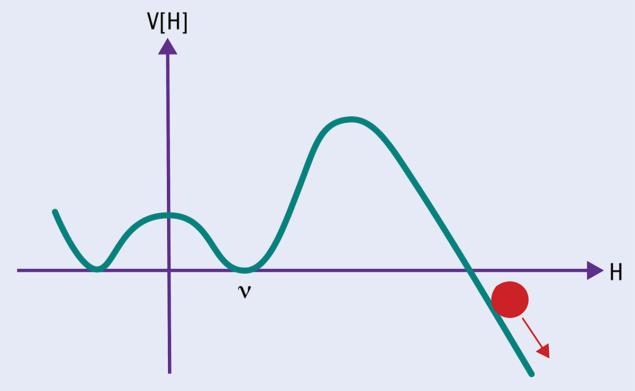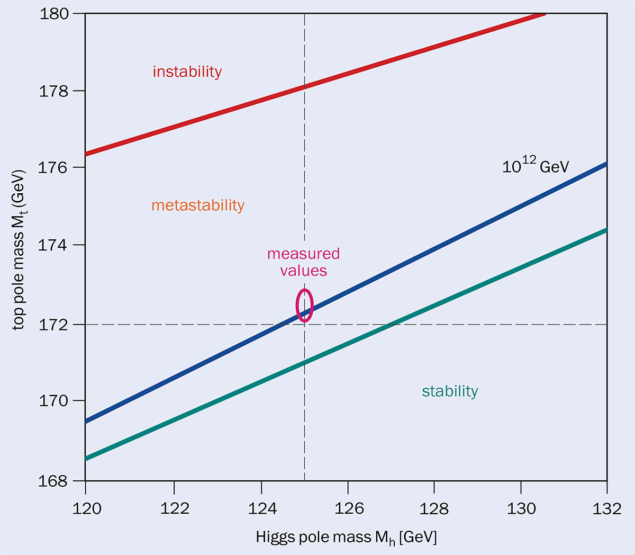The masses of the Higgs boson and the top quark hint that there must be physics beyond the Standard Model that prevents the universe from decaying into a new vacuum state, argues John Ellis.

A vacuum is ordinarily pictured as an empty region containing no particles, atoms or molecules of matter, as in outer space. To a particle physicist, however, it is better defined as the lowest energy state that can be attained when no physical particles are present. Even in empty space there are fields that are invisible to the naked eye but nevertheless influence the behaviour of matter, while quantum mechanics ensures that, even if particles are not physically present, they continually fluctuate spontaneously in and out of existence.
In the Standard Model (SM), in addition to the familiar gravitational and electromagnetic fields, there is the Brout–Englert–Higgs (BEH) field that is responsible for particle masses. It is usually supposed to have a constant value throughout the universe, namely the value that it takes at the bottom of its “Mexican hat” potential (see “New depths” figure). However, as was first pointed out by several groups in 1979, and revisited by many theorists subsequently, the shape of the Mexican hat is subject to quantum effects that change its shape. For example, the BEH field has self-interactions that tend to curl the brim of the hat upwards, but there are additional quantum effects that tend to curl the brim downwards, due to the interactions with the fundamental particles to which the BEH field gives mass. The most important of these is the heaviest matter particle: the top quark.
Push and pull
The upward push of the Higgs boson’s self-interaction and the downward pressure of the top quark are very sensitive to their masses, and also to the strong interactions, which modify the effect of the top quark. Experiments at the LHC have already determined the mass of the Higgs boson with a precision approaching 0.1%, and CMS recently measured the mass of the top quark with an accuracy of almost 0.2%, while the strong coupling strength is known to better than 1%. The latest calculations of the quantum effects of the Higgs boson and the top quark indicate that the brim of the Mexican hat turns down when the BEH field exceeds its value today by 10 orders of magnitude, implying that the current value is not the lowest energy and hence not the true vacuum of the SM. A consequence is that the current BEH value is not stable, because quantum fluctuations would inevitably cause it to decay into a lower-energy state. The universe as we know it would be doomed (see “On the cusp” figure).
However, there is no immediate need to panic. First, the universe is metastable with an estimated lifetime before it decays that is many, many orders of magnitude longer than its age so far. Second, one could perhaps cling to the increasingly forlorn hope that the prediction of a lower-energy state of the SM vacuum is somehow mistaken. Perhaps an experimental measurement going into the calculation has an unaccounted uncertainty, or perhaps there is some ingredient that is missing from the theoretical calculation of the shape of the Mexican hat?

If you simply take the calculation at face value and humbly accept the eventual demise of the universe as we know it, however, a further problem arises. Since quantum and thermal fluctuations in the BEH field were probably much larger when the universe was young and much hotter than today, the overwhelming majority of the universe would have been driven into the lower-energy state. Only an infinitesimal fraction would be in the metastable state we find ourselves in today, where the value of the BEH field is relatively small. Of course, one could argue anthropically that this good luck was inevitable, as we could not live in any other “vacuum” state.
To me, this argument reeks of special pleading. Instead, my instinct is to argue that some physics beyond the SM must appear below the turn-down scale and stabilise the vacuum that we live in. This argument is not specific about the type of new physics or the scale at which it appears. One extension of the SM that fits the bill is supersymmetry, but the stability argument offers no guarantee that this or any other extension of the SM is within reach of current experiments.
It used to be said that the nightmare scenario for the LHC would be to discover the Higgs boson and nothing else. However, the measured masses of the Higgs boson and the top quark may be hinting that there must be physics beyond the SM that stabilises the vacuum. Let us take heart from this argument, and keep looking for new physics, even if there is no guarantee of immediate success.





